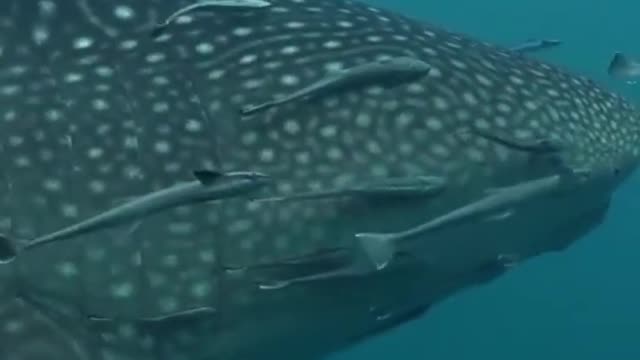Premium Only Content

Whales #sea #ocean #fish #shorts #
Nomenclature
The genus name, Balaenoptera, means winged whale[3] while the species name, musculus, could mean "muscle" or a diminutive form of "mouse", possibly a pun by Carl Linnaeus[4][3] when he named the species in Systema Naturae.[5] One of the first published descriptions of a blue whale comes from Robert Sibbald's Phalainologia Nova,[6] after Sibbald found a stranded whale in the estuary of the Firth of Forth, Scotland, in 1692. The name "blue whale" was derived from the Norwegian "blåhval", coined by Svend Foyn shortly after he had perfected the harpoon gun. The Norwegian scientist G. O. Sars adopted it as the common name in 1874.[7]
Blue whales were referred to as 'Sibbald's rorqual', after Robert Sibbald, who first described the species.[6] Herman Melville called the blue whale "sulphur bottom" in his novel Moby Dick[8] because of the accumulation of diatoms creating a yellowish appearance on their pale underside.[4][9]
Evolution
Balaenopteridae
Minke whale
B. musculus (blue whale)
B. borealis (sei whale)
Eschrichtius robustus (gray whale)
B. physalus (fin whale)
Megaptera novaeangliae (humpback whale)
A phylogenetic tree of six baleen whale species[10]
Blue whales are rorquals in the family Balaenopteridae. A 2018 analysis estimates that the Balaenopteridae family diverged from other families in between 10.48 and 4.98 million years ago during the late Miocene.[10] The earliest discovered anatomically modern blue whale is a partial skull fossil found in southern Italy, dating to the Early Pleistocene, roughly 1.5–1.25 million years ago.[11] The Australian pygmy blue whale diverged during the Last Glacial Maximum. Their more recent divergence has resulted in the subspecies having a relatively low genetic diversity,[12] and New Zealand blue whales have an even lower genetic diversity.[13]
Whole genome sequencing suggests that blue whales are most closely related to sei whales with gray whales as a sister group. This study also found significant gene flow between minke whales and the ancestors of the blue and sei whale. Blue whales also displayed high genetic diversity.[10]
-
 21:25
21:25
JasminLaine
13 hours agoMark Carney Gets Visibly ANGRY at Reporter—Poilievre BURIES Him! Then He Goes Into HIDING
8.36K12 -
 16:56
16:56
Clownfish TV
1 day agoDisney's DEATH by Tariffs? They DEPEND on China!
15.2K7 -
 11:30
11:30
IsaacButterfield
1 day ago $0.74 earnedThis Hate Speech Law Is RACIST To White People.
10.5K15 -
 14:57
14:57
BEK TV
1 day agoEP 6 - DUNSEITH DECLASSIFIED: RESPECTED NATIONAL MEDIA LEGAL EXPERT WEIGHS IN
17.3K -
 29:59
29:59
The Brett Cooper Show
3 days ago $15.32 earnedHow This Sparked A MASSIVE Parenting Debate Online | Episode 20
57.7K89 -
 17:55
17:55
DeVory Darkins
17 hours ago $22.55 earnedCNN crushed by pronouns as Trump scores HUGE VICTORY
83.9K77 -
 2:48:33
2:48:33
Barry Cunningham
18 hours agoWATCH LIVE: MY INTERVIEW WITH LARA TRUMP! AND TODAY'S NEWS ABOUT DEMOCRATS HATING AMERICA!
122K28 -
 3:12:15
3:12:15
TimcastIRL
11 hours agoLiberals BLAME TRUMP For NYC Tourist Helicopter Crash After Tragic Accident | Timcast IRL
284K185 -
 1:16:36
1:16:36
Glenn Greenwald
14 hours agoGlenn Takes Your Questions: On Banning Candidates in the Democratic World, Expanding Executive Power, and Trump's Tariffs | SYSTEM UPDATE #437
141K52 -
 40:09
40:09
Friday Beers
12 hours ago $7.13 earnedWii Golf Gets Heated: Friday Beers vs Full Squad Gaming
69.1K1